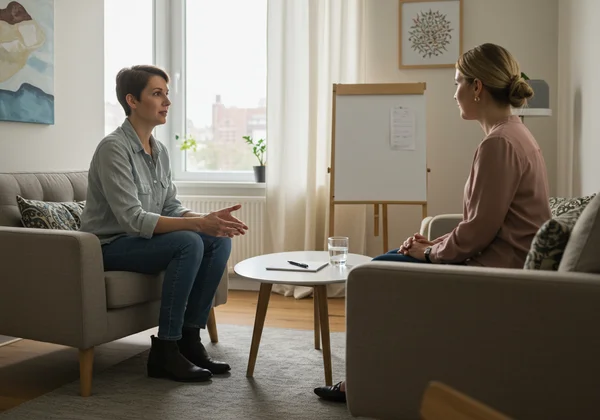Start Your CPTSD Healing Journey: Coping & First Steps
Feeling overwhelmed by the persistent echoes of past trauma can be an incredibly isolating experience. If you find yourself grappling with intense emotions, difficult relationships, and a negative self-image, know that you are not alone and what you're feeling is valid. The path forward might seem foggy, but starting the CPTSD healing journey is possible, beginning with gentle, actionable steps. Many people in your position often wonder, what is the first step in healing CPTSD? This guide offers a compassionate roadmap, focusing on practical coping skills and the initial actions you can take to reclaim your life.
The very first step is often gaining clarity. Finding answers frequently starts with a reliable cptsd test. Understanding how your experiences align with the symptoms of Complex PTSD can be a powerful act of self-validation. To support you on this first step, you can start your self-assessment with a free, confidential screening tool based on the International Trauma Questionnaire (ITQ). This can provide the insights needed to move forward with confidence.

Understanding Your CPTSD Healing Journey
Embarking on a healing journey requires patience and self-compassion. Unlike healing a broken bone, recovering from complex trauma isn't about "fixing" something that is broken, but rather about integrating your experiences and learning new ways to relate to yourself and the world. It’s a process of rediscovering your inner strength and resilience.
What is the First Step in Healing CPTSD?
The single most important first step is acknowledgment and psychoeducation. This means acknowledging that your struggles are real and are likely a direct result of the prolonged or repeated trauma you endured. It involves stepping away from self-blame and recognizing your reactions as normal responses to abnormal situations.
Psychoeducation is the process of learning about CPTSD. Understanding its core symptom clusters—difficulties with emotional regulation, disturbances in self-concept, and relational challenges—can feel like turning a light on in a dark room. Suddenly, confusing and chaotic experiences start to make sense. This is why a preliminary free CPTSD test can be so empowering; it provides a structured framework to understand your feelings and behaviors.
The Non-Linear Path of Complex Trauma Recovery
It is vital to understand that complex trauma recovery is not a straight line. There will be periods of significant progress, followed by moments where old patterns or intense feelings resurface. This is not failure; it is a normal part of the healing process.
Think of it like learning to navigate a vast and varied landscape. Some days you'll be walking on a smooth, flat path, and other days you might have to climb a steep hill. Celebrating the small victories and being gentle with yourself during the challenging moments are key. Each step, no matter how small, is a move toward a more integrated and peaceful life.

Foundational Coping Skills for Complex Trauma
Before you can tackle the deeper work of trauma processing, you need to build a foundation of safety and stability in your daily life. Developing coping skills for complex trauma helps you manage symptoms so you feel more in control and less overwhelmed. These skills are your toolkit for navigating the day-to-day challenges of CPTSD.
Cultivating Safety & Grounding Techniques
When you have CPTSD, your nervous system can be on high alert, easily triggering a "fight, flight, or freeze" response. Grounding techniques are simple yet powerful exercises that pull you out of an emotional flashback or a state of panic and anchor you in the present moment.
-
The 5-4-3-2-1 Method: Look around and name 5 things you can see, 4 things you can touch, 3 things you can hear, 2 things you can smell, and 1 thing you can taste.
-
Temperature Change: Hold an ice cube in your hand or splash cool water on your face. The sudden change in temperature can quickly bring your awareness back to your body.
-
Body Awareness: Press your feet firmly into the floor. Notice the sensation of the ground beneath you, supporting you. This simple act can counteract feelings of floating or dissociation.

Emotion Regulation: Managing Intense Feelings
Emotional dysregulation—swinging from intense anger to deep sadness or numbness—is a hallmark of CPTSD. Emotion regulation is not about suppressing your feelings but learning to experience them without becoming completely overwhelmed.
Start by practicing emotional literacy. Simply name the emotion you are feeling ("I am feeling angry," "I am feeling afraid") without judgment. This creates a small space between you and the emotion, giving you a moment to choose your response instead of reacting automatically. Deep, slow breathing exercises can also calm your nervous system and reduce the intensity of your feelings.
Setting Healthy Boundaries & Reclaiming Your Space
Prolonged trauma often erodes a person's sense of personal boundaries. Learning to set healthy boundaries is a radical act of self-care and respect. It involves identifying your needs and limits and communicating them clearly to others.
This can be as simple as saying, "I can't talk about that right now," or "I need some time to myself." It is about protecting your energy and creating safe relationships. At first, it may feel uncomfortable or selfish, but it is essential for building a life where you feel respected and secure.
Taking Action: Practical First Steps Towards Healing
Once you have some foundational coping skills, you can begin taking proactive steps toward long-term healing. These actions help you build a life that supports your recovery and well-being.
Building a Supportive Network
Isolation is a common struggle for those with CPTSD, but connection is a powerful antidote. Actively building a supportive network of safe, trustworthy people is crucial. This doesn't have to be a large group; even one or two validating friends, family members, or a support group can make a world of difference. Seek out people who listen without judgment and respect your boundaries.
Exploring Professional Support & Therapy Options
While self-help strategies are invaluable, working with a trauma-informed therapist is often a necessary component of deep healing. A professional can provide a safe space to process traumatic memories and guide you through evidence-based treatments like EMDR (Eye Movement Desensitization and Reprocessing) or IFS (Internal Family Systems).
Taking a confidential cptsd test online can be an excellent starting point for this conversation. Bringing your CPTSD self-assessment results to a therapist can help them quickly understand your symptoms and tailor a treatment plan for you.

The Power of Self-Compassion on Your Journey
Perhaps the most transformative tool in your healing journey is self-compassion. The inner critic is often loud and relentless for trauma survivors, fueling feelings of shame and worthlessness. Self-compassion is the practice of treating yourself with the same kindness and understanding you would offer a dear friend.
When you make a mistake or have a difficult day, try to notice the self-critical thoughts and consciously replace them with a kinder, more supportive inner voice. Remind yourself that you are doing the best you can with the tools you have. This practice rewires your brain for safety and acceptance.
Your Healing Journey Starts Here: Embrace Each Step
Your CPTSD healing journey is uniquely your own. It is a testament to your strength and your desire for a better life. The path begins with the first step: acknowledging your pain and seeking to understand it. From there, you can build a foundation of safety with coping skills and take brave, practical actions toward a brighter future.
Remember, you don't have to have it all figured out right now. All you need to do is take the next gentle step. If you're ready to gain clarity and validate your experiences, take our free CPTSD test today. It’s a confidential, secure, and empowering way to begin.
Frequently Asked Questions About CPTSD Healing
What is the first step in healing CPTSD? The most critical first step is acknowledgment and education. This means accepting your experiences as valid and learning about how complex trauma impacts the mind and body. A great way to start this process is by using a confidential CPTSD screening test to gain objective insights into your symptoms.
What everyday struggles do people with CPTSD face? Everyday struggles can be vast and varied. They often include difficulty trusting others, intense emotional reactions to minor stressors (emotional flashbacks), a persistent feeling of worthlessness or shame, chronic physical pain or fatigue, and a sense of being disconnected from oneself and the world (dissociation).
Do people with CPTSD cry often? It varies greatly. Some people with CPTSD may cry often as they experience intense waves of grief, sadness, or frustration. Others may experience emotional numbing, where they feel unable to cry or access their emotions at all. Both are normal responses to trauma.
What are the 4 F's of CPTSD? The "4 F's" are common trauma responses:
- Fight: Reacting with anger, aggression, or a need to control.
- Flight: Escaping the situation, avoiding conflict, or feeling anxious and panicked.
- Freeze: Feeling stuck, numb, dissociated, or unable to move or speak.
- Fawn: People-pleasing, abandoning personal needs to appease others and avoid conflict.
Disclaimer: This article is for informational purposes only and does not constitute medical advice. The test provided on this website is a screening tool, not a diagnostic instrument. Please consult with a qualified mental health professional for an accurate diagnosis and treatment plan.